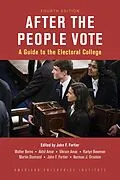Now in its fourth edition, After the People Vote remains an indispensable concise guide to help students and all citizens understand this critical and controversial American political institution. The mechanisms that lead to the final selection of a president are complex. Some procedures are sketched out in the original Constitution and its amendments, and others in federal law, congressional rules and procedures, state laws, and political party rules. This new, expanded edition of After the People Vote-featuring new sections on public opinion on the Electoral College and proposals for amending the Electoral College system-explains how our system of electing a president works, especially the processes that kick in after the November general election date.
Autorentext
Edited by John C. Fortier
Klappentext
Now in its fourth edition, After the People Vote remains an indispensable concise guide to help students and all citizens understand this critical and controversial American political institution. The mechanisms that lead to the final selection of a president are complex. Some procedures are sketched out in the original Constitution and its amendments, and others in federal law, congressional rules and procedures, state laws, and political party rules. This new, expanded edition of After the People Vote-featuring new sections on public opinion on the Electoral College and proposals for amending the Electoral College system-explains how our system of electing a president works, especially the processes that kick in after the November general election date.
Inhalt
Contents
Introduction
Timeline for the Presidential Elections of 2020, 2024, and 2028
Part I. How the Electoral College Works
1. How Are Electors Appointed?
2. For Whom Do Electors Vote?
3. How Are the Electoral Votes Counted?
4. What If No One Has a Majority?
5. What If No One Has Been Chosen by Inauguration Day?
6. What If a Major-Party Candidate Dies or Resigns?
7. Changing the Electoral College
Part II. The History of Disputed Elections
8. Three Disputed Elections: 1800, 1824, 1876
Norman J. Ornstein
9. The 2000 Election
John C. Fortier
Part III. Arguments for and Against the Electoral College
10. Let's Hear It for the Electoral College
Walter Berns
11. Why Old and New Arguments for the Electoral College Are Not Compelling
Akhil Reed Amar and Vikram David Amar
12. Excerpts from "The Electoral College and the American Idea of Democracy"
Martin Diamond
13. Public Opinion on the Electoral College
Karlyn Bowman
About the Authors
Notes
Appendixes
A. Provisions in the Constitution for Presidential Selection
B. Statutory Provisions for Presidential Selection
C. Nomination and Binding of Presidential Electors
D. 1825 Precedents
E. Party Rules
F. Allocation of Electoral Votes Among the States for 2004 and 2008
G. Faithless Electors
H. Electoral College and Popular Vote Outcomes of All Elections
